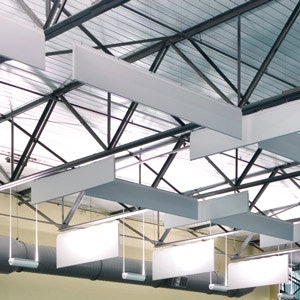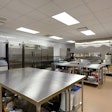
This article appeared in the May issue of Athletic Business. Athletic Business is a free magazine for professionals in the athletic, fitness and recreation industry. Click here to subscribe.
Poor acoustics in a recreation facility can be more than a mere nuisance. It can inhibit conversation, yes, but it can also interfere with coaching instruction and even be a safety issue (for example, when swimmers can't understand the lifeguard). In multigenerational centers, the presence of older adults with hearing impairments makes good acoustics even more of a necessity, as does the trend toward rec facilities sharing a footprint with other community functions, such as meeting rooms, studios and libraries. Ideally, sound should be controlled within a space's walls, and it mustn't be allowed to impact other spaces.
These are buildings that often are made up of large open volumes and hard surfaces, yet surprisingly, many architects deal with acoustical treatments as if they were simply FF&E (furniture, fixtures & equipment). Avoiding the issue during design may help the construction budget then, but at what cost? Budgeting for acoustics in the design stage makes for a more functional and pleasant building and is less costly than putting acoustic considerations off until the end of the project.
CHOOSING THE RIGHT MATERIALS
Poor acoustics stem from many causes, beginning with physical laws that govern how sound waves behave when they strike a surface. The basic geometry of a space has a lot to do with how sound behaves in it. Most rooms have parallel walls, which reflect sound waves back and forth, creating reverberation. Simply creating divergent wall planes, or sloping the roof, will help to scatter sound. In general, anything done to break up a wall plane will help a room acoustically, even if it's just the insertion of a series of windows.
Texture also helps to reflect sound waves in different directions (irregular surfaces) or absorb them (porous materials), and many of the most effective acoustical treatments use texture and structure to reduce reverberation. At Brinkley Sargent Wiginton, our experience with large volumes in buildings informs our decision-making about acoustics, but we often engage an acoustical consultant to — in essence — check our math. The consultant's calculations of expected reverberation times will help us determine both the placement and amount of various acoustical materials.
When considered during the design of the building, questions of where, what kind, how much and what does it look like are properly vetted so as not to come off later as an afterthought:
 Perforated roof decking. (Courtesy of Epic Metals)
Perforated roof decking. (Courtesy of Epic Metals)
• Perforated roof decking is a typical method of dealing with sound in spaces like gymnasiums or natatoriums with high exposed ceilings. Like a drop ceiling in an office, a sound-absorptive roof can have a dramatic effect on the acoustics of a space. The advantage here is that the client gets acoustical value from the structural roof system — a sort of two-for-one — versus adding a ceiling treatment. The acoustical value of the roof deck varies widely depending on its depth, amount of perforation, and if the space behind the baffles is open or insulated. The disadvantage, of course, is that it cannot be added later. There is only one chance to make this decision correctly.
 Acoustic brick
Acoustic brick
Courtesy of San Marco Terreal
• Acoustical block walls are a commonly used product, featuring partially exposed cavities that are filled with glass fiber insulation. This is a material that we tend to avoid, as openings invite knuckleheads to put gum and candy wrappers in them. When we do choose acoustical block, we limit it to areas above reach, even if this mitigates its effectiveness (you want to capture sound where it's being made). Avoid acoustical block natatoriums, since the cavities provide stagnant places for moisture to collect.
 Acoustic Clouds
Acoustic Clouds
Courtesy of Serge Ferrari (Photo by Andrea Liverani)
• Acoustical panels are fabricated from a variety of materials, such as metal, wood fiber, fiberglass, various foams and fabrics, and combinations thereof. They are attached directly to walls or can be offset a bit, creating a hollow space that can itself be insulated, adding to the acoustic properties of the panels. Some materials can be used in their natural color or painted. Panels can also be used on the underside of bare roof decks, hung like "clouds" or as part of a ceiling system.
 Sound baffles
Sound baffles
Tom Muehlenbeck Center, Plano, Texas
• Sound baffles are similar products that are hung in a space like banners, providing twice the surface area for sound absorption. They are often fabric-wrapped panels that come in a variety of fabrics and colors. Care must be taken when using baffles to coordinate them with lighting, so as not to create shadowing problems, and with mechanical systems and ceiling fans to avoid turning them into mobiles. The advent of high-velocity, low-speed fans has made baffles less practical in some spaces.
 Spray-on coatings
Spray-on coatings
Courtesy of International Cellulose Corporation
• Spray-on coatings sometimes perform double duty as a fire retardant and a sound deadener, but they're generally best seen from a distance. The aesthetic drawbacks of the method (it can resemble popcorn) are sufficient to relegate its use to the ceilings of parking garages or of very high-volume spaces.
 Soft furniture
Soft furniture
NRH Centre, North Richland Hills, Texas
• Soft furniture in a lobby space can make a big difference in terms of noise. Most facility operators want furniture that's easy to wipe down, which usually translates into harder surfaces, so a decision has to be made about which is more important, maintenance or sound attenuation. Consider vinyl cushions and chair backs as a way to have both.
 Floor surfaces
Floor surfaces
The Summit at Central Park, Grand Prairie, Texas
• Floor surfaces such as carpet help tremendously in controlling sound, but we're seeing a pushback on carpet specified in cardio spaces in particular because of its tendency to hold sweat. It used to be fairly typical for a cardio space to be fully carpeted, with rubber mats under the equipment to help deal with olfactory issues. Now we're seeing preference given to fully rubber floors for ease of maintenance. While rubber floors are better than a hard floor from a sound perspective, they're simply not as effective acoustically as carpet. An effective compromise is to flip the script, using rubber under equipment, broken up by carpeted pathways.
We've found ways of introducing materials that will help control noise but do so surreptitiously. For example, at The Summit, a Grand Prairie, Texas, multigenerational center, concern over possible excess noise in the gym led us to specify wall pads that run the length of the gym wall. These are ordinarily located just behind basketball goals, for safety reasons, but at The Summit, the additional padding improves the gym's acoustics while it improves the gym's appearance. The pads arguably made the wall safer, even if that wasn't the intent.
SOUND STRATEGIES
As important as materials selection is to the acoustical performance of a space, it is a sort of second step after the macro elements of room geometry and the installation of mechanical and electrical equipment. Audio systems get plenty of attention in the design of arenas, where poor placement or improper aiming can doom intelligibility and lead to unfortunate echoes and dead zones in the seating bowl, but similar audio issues crop up in natatoriums, gymnasiums, and even lobbies and fitness centers. This is an issue in particular flux as personal audio overtakes public audio, with implications in the realm of safety as well as entertainment.
Mechanical noise is another area that requires a good deal of thought, both because of vibration caused by rooftop HVAC equipment and the sound made by incoming and outgoing air. The former is usually isolated by placing equipment on springs or pads, while the latter creates a planning challenge. At Southern Methodist University, the currently under-construction Robson and Lindley Aquatics Center will be a massive, tall volume, since it must accommodate a 50-meter pool, a diving platform and spectator seating. While requirements for air changes in such a large volume ordinarily dictate enormous ducts, another option is faster air speeds in smaller ductwork — but more air being pushed through smaller openings generates more noise. After testing multiple scenarios with our mechanical engineer and acoustician, we were able to figure out the sweet spot where we could still fit the ducts through our structure without them howling obnoxiously.
When planning acoustically appropriate spaces, adjacencies also come into play. Acoustical consultants speak in terms of "sound transmission coefficient," which is a rating of how much sound travels through a structure such as space partitions, walls and floors. ("Noise reduction coefficient," by contrast, is a rating assigned to materials of how much sound they absorb.) But knowledge of STC and NRC may not stop an inexperienced architect from putting the Zumba studio off the lobby, or the free-weight area above a suite of classrooms. There are ways to design such adjacencies where they must exist, but it is generally easier to avoid a problem from the outset rather than to solve it after the fact. Part of the solution in such a circumstance at The Summit was to install very thick athletic flooring to absorb impact noise. Cleanly accommodating this flooring system involves coordination and consideration with the floor structure itself.
The essence of planning is understanding how each space in a building will actually be used, and what the building's owner and users expect from each space. Acoustical planning follows this same template, and tradeoffs are common in each. A recreation facility will ordinarily have one noisy end of the building (natatorium dehumidification equipment above the pump and filter room), but if circumstances require it, a building plan might place air-handling equipment above transient space such as the locker room. At other times, asking the right questions about space utilization will simplify the process of planning for sound control. For example, at SMU, we knew the client intended to hang big banners and flags in the natatorium, so we were able to take them into account as we devised an acoustical strategy for the space.
Putting off acoustics until after your building opens just isn't a sound strategy. Acoustical treatments shouldn't look or function as an add-on, and some of the most effective treatments need to be integrated into the design to work well. You only get one chance to do that.
Stephen Springs, AIA ([email protected]) is a principal with Brinkley Sargent Wiginton Architects in Dallas.
This article originally appeared in the May 2016 issue of Athletic Business with the title "Designing a new facility? Don’t forget the acoustics"





































